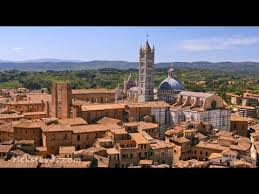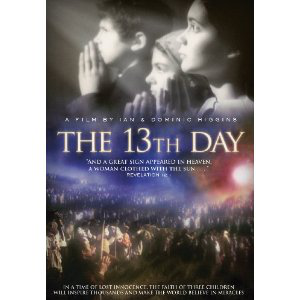Filmmakers Ian & Dominic Higgins may have been happier had I reviewed their film, The 13th Day, at the time of last year’s theatrical release. But how would I have seen it until its recent appearance on DVD? The prior distribution – if you can call it that – was a matter of producer-organized screenings, usually in Catholic churches and auditoriums and none was in New York where I live. But this isn’t their fault, and it can hardly have been otherwise. As excellent as the movie is, it’s not a project destined to win the assistance of Hollywood distributors.
I call it “excellent” not “great.” Every motion picture has its strengths and weaknesses, and the virtues of The 13th Day far outweigh its vices. One measure of any movie – big-budget or small – is how much of the investment (writing, casting, time, money) ends up on the screen, and The 13th Day puts its last penny right where you can see and enjoy it.
It is, of course, the story of the six Marian apparitions at Fátima, each on the thirteenth day of the month and beginning in May, 1917. Controversial from the start, the appearances of Our Lady of Fátima still rile debate, especially about the three secrets the Virgin gave to the three Portuguese children, Lúcia Dos Santos (played superbly in The 13th Day by Filipa Fernandes), Jacinta Marto (Ana-Sofia Vilas Boas), and Francisco Marto (Victor Machado). But the movie is very much more about the children than the secrets, and that is its primary asset and its principal fault. But it’s a small fault.
The secrets, the last revealed only during the papacy of John Paul II (and the release of which was handled by Joseph Cardinal Ratzinger), involve, as most know, wars and rumors of wars. Their somewhat cursory depiction in the movie is very much in the visual style of the rest of the film, except – like parts of the visitations themselves – done in color rather than in the film’s otherwise stunning black-and-white. The look of The 13th Day struck me as a an homage of sorts to the newly voguish Frank Miller-style graphic-novel effects of 300 and Sin City and the venerable silent-film imagery of Carl Theodor Dreyer (The Passion of Joan of Arc) . . . with a bit of Pier Paolo Passolini (The Gospel According to St. Matthew) thrown in, especially in the Higgins’ affection for tight shots of interesting, even disturbing faces.
The cast is made up of English and Portuguese actors, and their performances are mostly first-rate (Jane Lesley is especially fine as Lúcia’s mother), and – as was true of Passolini’s films – even those actors who are not master thespians seem right in the story of peasants who suddenly confront, with initial skepticism and later devotion, one of the true miracles of our age.
The story is Lúcia’s. She’s the one who, looking back on these events from the convent where she retired and writing down her memories, provides narration. For all the glory of the encounters with Our Lady, the overall experience was horrifying. The Virgin’s message of peace and repentance notwithstanding, the children were not only given a vision of hell, they lived through a hellish six months.
“I offered my suffering to God,” Lúcia recalls, “and thought of all the souls I was saving.”
That suffering included imprisonment by Portuguese authorities, who put the kids in a cell with hardened criminals, a scene at the heart of The 13th Day. It is scary, believable, and magnificent. Jacinta is forced to dance with one of the thugs, and the tension is agonizing until little Francisco kneels and prays. The rest – including the despicable threats made against the children by their jailers – you simply have to see for yourself.
Almost everybody I know, including many Catholics, considers the miracles at Fátima to be humbug. It has taken me many, many years to comfortably, confidently believe not only in Our Lady’s appearances at Guadalupe, Lourdes, and Fátima, but even in the miracles of Christ as recorded in the Bible. We live in an age of gaudy skepticism. I Googled “miracles roman catholic teaching” and the first of 1,690,000 results was “The Hoax of Our Lady of Fátima.” (I didn’t bother with it, since the main source of its refutation is called the National UFO Center.) What I’ve come to understand is this: We resist miracles, and so we see no miracles. “A wicked and adulterous generation looks for a miraculous sign, but none will be given it except the sign of Jonah.” (Matthew 16:4)
But shepherd children may see.
Every day at Mass there is a miracle, which is why I now go every day. And there are other miracles. There’s our Sun. It may not dance for us as it did at Fátima on October 13, 1917, but it’s no less a miracle for being just where God put it. It may be fiery cauldron 93,000,000 miles away, but you feel its gentle warmth touching your face. Or as Pope Benedict said just the other day at Fátima:
[The miracle of Christ] has the power to come to us, particularly through our inner senses, so that the soul can receive the gentle touch of a reality which is beyond the senses and which enables us to reach what is not accessible or visible to the senses.
In the end, the message of The 13th Day is Our Lady’s plea to the generation of Lúcia . . . and every generation: Pray the Rosary for peace.
















